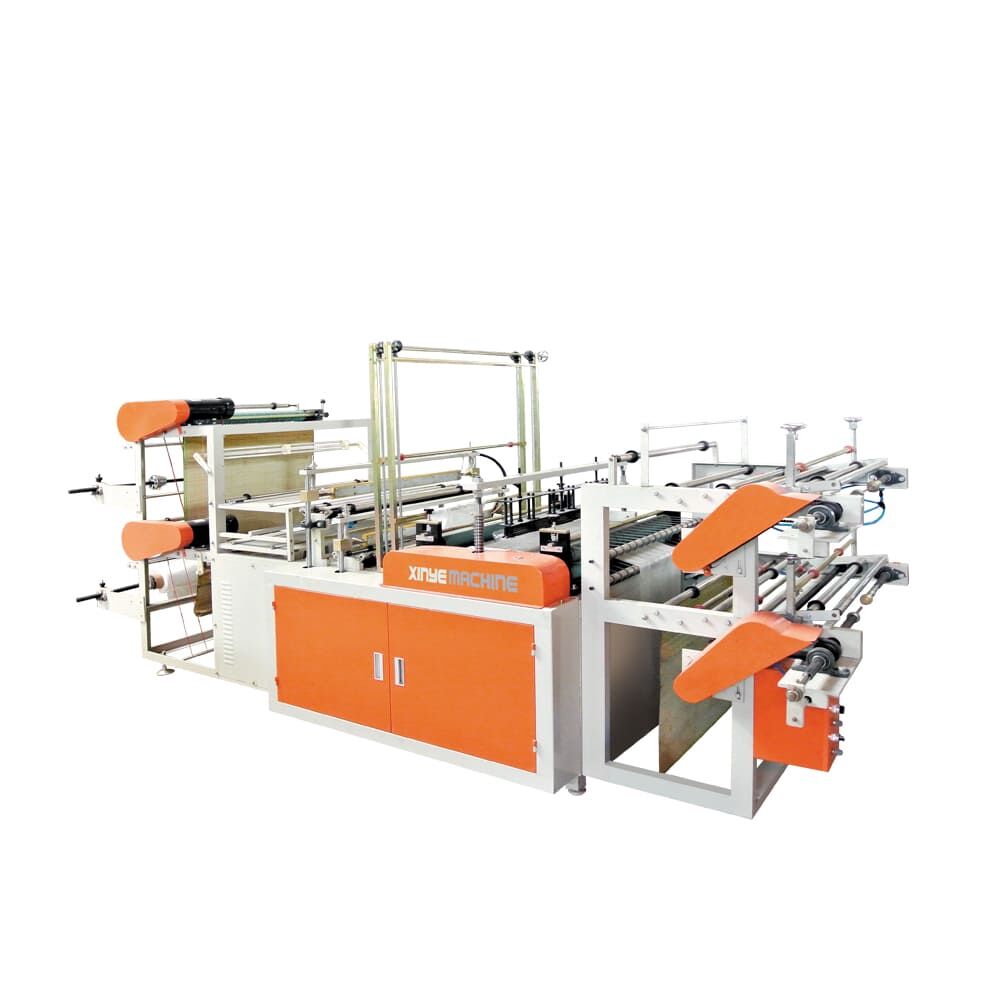How Automated Web Guidance Systems Improve Real-Time Alignment in Bag Manufacturing
Real-time control of lateral deviation in film and substrate materials
Web guidance systems that are automated help get rid of those pesky alignment issues because they keep an eye on where materials are positioned through either ultrasonic or infrared technology. When there's a sideways shift happening, these systems can catch it fast - talking about corrections down to plus or minus 0.1 mm within just 50 milliseconds. That kind of accuracy really matters for important tasks such as sealing pouches properly or attaching handles without problems. According to what we've seen from industry reports, companies implementing this tech typically see around a two thirds drop in how much variation occurs at the edges when compared with old fashioned manual methods. Packaging Digest mentioned something similar back in 2023 if anyone wants to check their numbers.
Integration with continuous web handling systems for seamless operation
Modern web guidance systems integrate directly with unwind/rewind stations, printing units, and laminators via standardized PLC protocols. This synchronization enables uninterrupted production even at high speeds.
| Manual Systems | Automated Systems |
|---|---|
| 3–5% material waste | ≤0.8% waste |
| Frequent line stoppages | Continuous operation at 300 m/min |
| Operator-dependent adjustments | Autonomous correction cycles |
A leading packaging machine manufacturer reported 98.7% uptime after deploying integrated web guidance across their bag production lines.
Sensor-based feedback loops and closed-loop control advantages
Modern systems now incorporate edge detection cameras along with laser sensors to build material pathways that can adjust themselves when dealing with different substrate issues like film stretching or expansion caused by moisture. The closed loop design cuts down on wasted materials during setup by around 42 percent compared to older open loop methods thanks to something called predictive position compensation. This finding comes from page 18 of the latest Flexible Packaging Report published in 2024. What makes these smart systems so valuable is their ability to keep things aligned accurately even when switching between different types of materials quickly, maintaining precision within plus or minus 0.25 millimeters throughout the process.
Core Principles of Precision Web Alignment in High-Speed Bag Production
Fundamental Mechanics of Automated Web Guidance Systems
The systems work by syncing sensors with actuators to hit that sweet spot of positioning accuracy around plus or minus 0.25 mm, which is pretty impressive considering they can handle speeds above 800 feet per minute. When it comes to detecting when things start drifting sideways, infrared sensors team up with load cells to spot those issues early. Then comes the action part where servo driven rollers kick in and correct the web path within just about 20 milliseconds flat. Factory tests have shown these setups maintain stable alignment at roughly 99.4 percent throughout full day operations. That kind of reliability matters a lot in plants making thousands upon thousands of polyethylene and polypropylene bags every shift.
Edge and Line Detection Technologies for Accurate Tracking
Modern systems employ dual-phase detection:
- Edge guiding: Laser sensors with 0.05 mm resolution track substrate edges
- Line tracking: UV-reflective markers enable <0.1° angular correction in multi-layer laminates
Multi-spectral cameras resolve registration issues caused by transparent inks or metallic coatings, reducing misalignment-related scrap by 18% in textured materials.
Open-Loop vs. Closed-Loop Systems: Performance in High-Speed Environments
Closed-loop systems outperform open-loop configurations by 43% in error correction at 1,200 bags/hour due to real-time feedback:
| Parameter | Open-Loop | Closed-Loop |
|---|---|---|
| Correction latency | 85–120ms | 8–12ms |
| Material waste rate | 6.2% | 1.8% |
| Max sustainable speed | 650 fpm | 1,100 fpm |
Continuous PID (Proportional-Integral-Derivative) tuning compensates for mechanical wear, maintaining less than 0.3 mm variance over 8-hour shifts.
Key Applications of Web Guiding Technology in Bag Making Machines
Solving Registration Errors in Multi-Layer Lamination Processes
When making those multi layer bags, particularly ones used for medical barrier films, modern automated systems can spot even tiny shifts down to about half a millimeter either way. These machines then make real time corrections thanks to their edge detection sensors. Looking at what happened in flexible packaging last year shows something interesting too. Manufacturers who switched to closed loop steering saw roughly fifty two percent fewer alignment problems. That makes all the difference when trying to hit those super tight tolerances needed for sterile pouch applications where precision really counts.
Case Study: Retrofitting Legacy Bag Machines With Modern Guidance Systems
A Chinese packaging equipment provider upgraded 27 legacy bag-making machines with lateral web guides, achieving significant improvements:
- Material savings: 19% reduction in film waste through real-time edge tracking
- Speed optimization: Sustained throughput at 120 m/min (±0.5° angular correction)
- Downtime reduction: 72% fewer alignment-related stoppages versus manual systems
This retrofit approach proves older machinery can achieve modern precision without full replacement.
Performance Results From Industrial-Scale Installations
Data collected after installation at several manufacturing sites indicates that Automated Web Guidance Systems can cut down on material waste by around 23 to maybe even 30 percent during fast paced bag manufacturing operations. These systems rely on sensors to make corrections, keeping things aligned pretty accurately within plus or minus 0.3 millimeters while running at speeds as high as 150 meters per minute. That kind of precision really matters when it comes to tasks such as printing on woven polypropylene bags where alignment is everything. Looking at how these systems perform day to day, manufacturers have found that when response times stay below 100 milliseconds, they tend to save well over 180 thousand dollars each year just on those wide 8 meter film lines alone. The savings add up fast across multiple production runs.
Reducing Material Waste and Downtime with Automated Correction
Quantifying Scrap Reduction: Up to 30% Decrease Post-Integration
Automated Web Guidance Systems improve material utilization by correcting misalignments in real time. Studies show a 30% reduction in material waste due to minimized trimming losses during lamination and printing. By addressing deviations of ±0.2 mm early, these systems prevent cumulative errors that lead to defective batches.
| Metric | Manual Systems | Automated Systems | Improvement |
|---|---|---|---|
| Material Utilization | 78% | 91% | +13% |
| Scrap Rate | 22% | 9% | -59% |
Minimizing Manual Interventions and Unplanned Stoppages
Closed-loop control reduces reliance on operator adjustments by 85%, according to industry benchmarks. Predictive tension management and edge-positioning algorithms cut downtime by 40–60% by preventing common failures like web wrinkling or slippage. This supports uninterrupted 24/7 operations, while adaptive protocols maintain alignment integrity across speed ranges from 50 to 500 FPM.
Future Trends: Intelligent and AI-Driven Web Handling for Next-Gen Bag Machines
AI-Powered Predictive Correction in Automated Web Guidance Systems
The latest systems are incorporating artificial intelligence that can actually predict when alignment issues might happen by looking at live data from sensors monitoring things like material tension levels and surrounding environmental factors. These machine learning algorithms allow for adjustments to roller positions before problems occur, rather than waiting for something to go wrong first. According to recent industry reports from the Industry Analytics Group in their 2024 findings, companies that implemented these smart systems saw around 35 percent fewer instances where they had to make emergency fixes. This means less wear and tear on machinery over time, plus significantly fewer quality issues with products coming off production lines because there's far less chance of wrinkles forming or films getting torn during processing.
Streamlining Efficiency Through Smart, Adaptive Alignment
Today's manufacturing systems can actually teach themselves through something called reinforcement learning, which helps them adjust when materials change unexpectedly during production runs. This is different from old school fixed programming where everything had to be set beforehand. Instead, these smart systems constantly tweak how sensitive they are to various signals and how responsive they need to be. According to research published last year in the Next Generation Web Processing Study, factories using these adaptive approaches saw their setup times drop by around 22% when working with those complicated multi-layer laminators. What makes all this possible? These learning algorithms work so well that they maintain accuracy down to fractions of a millimeter even when running at blistering speeds of 1200 feet per minute. That kind of precision matters a lot for handling those fragile biodegradable films that tear so easily. And get this - modern closed loop feedback systems aren't just looking at basic parameters anymore. They're incorporating thermal expansion data too, which keeps things aligned properly over long production cycles without drifting off track.
FAQs
What is the function of automated web guidance systems in bag manufacturing?
Automated web guidance systems monitor and correct material alignment in real-time, helping to reduce lateral deviation and improve precision in processes like sealing and handle attaching.
How do these systems reduce material waste during bag production?
By correcting material alignment swiftly, automated systems minimize trimming losses and cumulative errors, reducing material waste rates compared to manual methods.
Can older bag-making machines be upgraded with automated systems?
Yes, legacy machines can be retrofitted with modern lateral web guides to enhance precision and reduce alignment-related stoppages without needing complete replacement.
What is the advantage of AI-driven automated web guidance systems?
AI-driven systems use predictive correction to foresee alignment issues and adjust roller positions proactively, reducing emergency fixes and enhancing product quality.
Table of Contents
- How Automated Web Guidance Systems Improve Real-Time Alignment in Bag Manufacturing
- Core Principles of Precision Web Alignment in High-Speed Bag Production
- Key Applications of Web Guiding Technology in Bag Making Machines
- Reducing Material Waste and Downtime with Automated Correction
- Future Trends: Intelligent and AI-Driven Web Handling for Next-Gen Bag Machines
- FAQs




